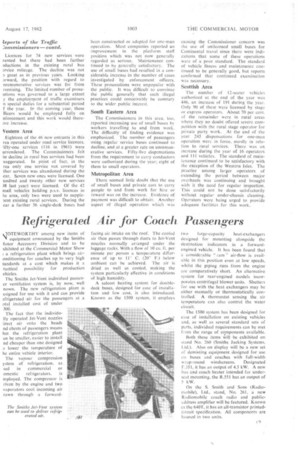Refrigerated Air for Coach Passengers
Page 39

If you've noticed an error in this article please click here to report it so we can fix it.
idOTEWORTHY among new items of '11 equipment announced by the Smiths 4otor Accessory Division and to be xhibited at the Commercial Motor Show ; a refrigeration plant which brings aironditioning for coaches up to very high tandards at a cost which makes it a ractical possibility for production
chides.
The Smiths Jet-Vent individual passener ventilation system is, by now, well nown. The new refrigeration plant is esigned for use with it and can provide efrigerated -air for the passengers at a otal installed cost of under 300.
The fact that the individully operated Jet-Vent nozzles lirect air onto the heads ncl chests of passengers means hat the refrigeration plant an be smaller, easier to install nd cheaper than one designed a lower the temperature of he entire vehicle interior. The vapour compression ystem of refrigeration, as sed in commercial or ornestic refrigerators, is mployed. The compressor is riven by the engine and two vaporators cool incoming air rawn through a forward
facing air intake on the roof. The cooled air then passes through ducts to Jet-Vent nozzles normally arranged under the luggage racks. With a flow of Hi Cu. ft, per minute per person a temperature difference of up to 11' C. (20° F.) below ambient can be achieved. The air is dried as well as cooled, making the system particularly effective in conditions of high humidity.
A saloon heating system for doubledeck buses, designed for ease of installation and low cost, is also introduced_ Known as the 1500 system, it employs two large-capacity heat-exchangers designed for mounting alongside the destination indicators in a forwardenained vehicle. It has been found that a considerable " ram" air-flow is available in this position even at low speeds, whilst the piping runs from the engine are comparatively short. An alternative System for rear-cngined models incorporates centrifugal blower units. Shutters for use with the heat exchangers may be either manually or thermostatically controlled. A thermostat sensing the air temperature can also control the water circuit.
The .1500 system has been designed for ease of installation ori existing vehicles and, as well as several standard sets of parts, individual requirements can be met from the range of components available.
Both these items will be exhibited on stand No. 260 (Smiths Jacking Systems, Ltd.). Also on display will be a new set of demisting equipment designed for use on buses and coaches with full-width wrap-round windscreens. Designated F.351, it has an output of 4.5 kW. A new bus and coach heater intended for underseat mounting, the R,551 has an output of 5 kW.
On the S. Smith and Sons (Radiomobile), Ltd., stand, No. 261, a new Radiomobile coach radio and publicaddress amplifier will be featured. Known as the 640T, it has an all-transistor printedcircuit specification. All components are housed in two units.












































































































